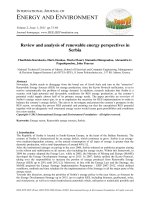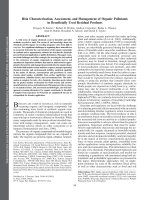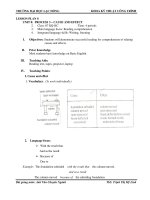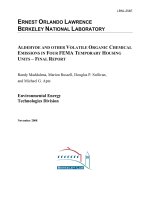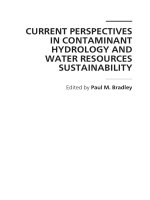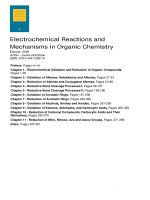Perspectives in supramolecular chemistry vol 8 separations and reactions in organic supramolecular chemistry
Bạn đang xem bản rút gọn của tài liệu. Xem và tải ngay bản đầy đủ của tài liệu tại đây (11.38 MB, 245 trang )
Separations and Reactions in Organic Supramolecular Chemistry: Perspectives in Supramolecular
Chemistry. Volume 8. Edited by Fumio Toda and Roger Bishop
Copyright 2004 John Wiley & Sons, Ltd. ISBN: 0-470-85448-0
Separations and Reactions
in Organic Supramolecular
Chemistry
Editorial Board
Founding Editor
J.-M. Lehn, Coll`ege de France, Chimie des Interactions Mol´eculaires, 11 Place
Marcelin Berthelot, 75005 Paris, France
Editors
C.J. Burrows, Office 3152 HEB, Department of Chemistry, University of Utah,
315 S. 1400 East, RM Dock, Salt Lake City, UT 84112, Utah, USA
G.R. Desiraju, University of Hyderabad, School of Chemistry, Hyderabad 500046,
India
A.D. Hamilton, Yale University, Department of Chemistry, New Haven, CT
06520, USA
D. Hilvert, Laboratorium f¨ur Organische Chemie, ETH Zentrum, Universit¨atsstrasse 16, 8092 Z¨urich, Switzerland
D.N. Reinhoudt, University of Twente, Faculty of Chemical Technology, P.O.
Box 217, NL-7500 AE Enschede, The Netherlands
J.-P Sauvage, Universit´e Louis Pasteur, Institut le Bel, 4 Rue Blaise Pascal,
F-67070 Strasbourg, France
Former Editors
J.-P. Behr, Facult´e de Pharmacie. Universit´e Louis Pasteur, Strasbourg, B.P. 24,
F-67401 Illkirch, France
T. Kunitake, Kyushu University, Faculty of Engineering. Hakozaki, Fukuoka 812,
Japan
Separations and Reactions
in Organic Supramolecular
Chemistry
Perspectives in Supramolecular
Chemistry
Volume 8
EDITED
BY
FUMIO TODA
Okayama University of Science, Japan
AND
ROGER BISHOP
University of New South Wales, Sydney, Australia
Copyright 2004
John Wiley & Sons Ltd, The Atrium, Southern Gate, Chichester,
West Sussex PO19 8SQ, England
Telephone (+44) 1243 779777
Email (for orders and customer service enquiries):
Visit our Home Page on www.wileyeurope.com or www.wiley.com
All Rights Reserved. No part of this publication may be reproduced, stored in a retrieval system or
transmitted in any form or by any means, electronic, mechanical, photocopying, recording,
scanning or otherwise, except under the terms of the Copyright, Designs and Patents Act 1988 or
under the terms of a licence issued by the Copyright Licensing Agency Ltd, 90 Tottenham Court
Road, London W1T 4LP, UK, without the permission in writing of the Publisher. Requests to the
Publisher should be addressed to the Permissions Department, John Wiley & Sons Ltd, The
Atrium, Southern Gate, Chichester, West Sussex PO19 8SQ, England, or emailed to
, or faxed to (+44) 1243 770620.
This publication is designed to provide accurate and authoritative information in regard to the
subject matter covered. It is sold on the understanding that the Publisher is not engaged in
rendering professional services. If professional advice or other expert assistance is required, the
services of a competent professional should be sought.
Other Wiley Editorial Offices
John Wiley & Sons Inc., 111 River Street, Hoboken, NJ 07030, USA
Jossey-Bass, 989 Market Street, San Francisco, CA 94103-1741, USA
Wiley-VCH Verlag GmbH, Boschstr. 12, D-69469 Weinheim, Germany
John Wiley & Sons Australia Ltd, 33 Park Road, Milton, Queensland 4064, Australia
John Wiley & Sons (Asia) Pte Ltd, 2 Clementi Loop #02-01, Jin Xing Distripark, Singapore 129809
John Wiley & Sons Canada Ltd, 22 Worcester Road, Etobicoke, Ontario, Canada M9W 1L1
Wiley also publishes its books in a variety of electronic formats. Some content that appears
in print may not be available in electronic books.
Library of Congress Cataloging-in-Publication Data
Separations and reactions in organic supramolecular chemistry / edited
by Fumio Toda and Roger Bishop.
p. cm. – (Perspectives in supramolecular chemistry ; v. 8)
Includes bibliographical references and indexes.
ISBN 0-470-85448-0 (cloth : alk. paper)
1. Supramolecular chemistry. 2. Chromatographic analysis. 3.
Chemical reactions. I. Toda, Fumio. II. Bishop, Roger. III. Series.
QD878 .S47 2004
2003020628
547 .1226 – dc22
British Library Cataloguing in Publication Data
A catalogue record for this book is available from the British Library
ISBN 0-470-85448-0
Typeset in 10/12pt Times by Laserwords Private Limited, Chennai, India
Printed and bound in Great Britain by Antony Rowe Ltd, Chippenham, Wiltshire
This book is printed on acid-free paper responsibly manufactured from sustainable forestry
in which at least two trees are planted for each one used for paper production.
Contents
Contributors
vii
Preface
ix
1 Inclusion Complexation as a Tool in Resolution
of Racemates and Separation of Isomers
Zofia Urbanczyk-Lipkowska and Fumio Toda
1
2 Enantiomer Ordering and Separation During Molecular
Inclusion
Roger Bishop
33
3 Molecular Recognition of Crystalline Dipeptides
and Its Application to Separation
Katsuyuki Ogura and Motohiro Akazome
61
4 Separation of Isomers and Enantiomers by Bile Acid
Derivatives
Mikiji Miyata, Nungruethai Yoswathananont,
Kazunori Nakano and Kazuki Sada
5 Physicochemical Studies of Separation of Isomers
by Supramolecular Systems
Luigi R. Nassimbeni
87
123
vi
6 Regioselective Synthesis of Fullerene Derivatives
and Separation of Isomers of the Higher Fullerenes
L. Echegoyen, M. A. Herranz, F. Diederich and C. Thilgen
7 Selective Reactions in Inclusion Crystals
Zofia Urbanczyk-Lipkowska and Fumio Toda
8 Supramolecular Control of Reactivity in the Solid State
Using Linear Templates
Leonard R. MacGillivray
Contents
137
173
185
9 Development of a New Biocide as an Inclusion Complex
Minoru Yagi, Ayako Sekikawa and Tetsuya Aoki
205
Cumulative Author Index
221
Cumulative Title Index
227
Index
231
Contributors
Motohiro Akazome, Department of Materials Technology, Faculty of Engineering, Chiba University, 1-33 Yayoicho, Inageku, Chiba 263–8522, Japan
Tetsuya Aoki, Kurita Water Industries Ltd, 4-7 Nishi-Shinjuku, 3-Chome, Shinjuku-ku, Tokyo 160–8383, Japan
Roger Bishop, School of Chemical Sciences, University of New South Wales,
UNSW Sydney NSW 2052, Australia
Fran¸cois Diederich, Laboratorium f¨ur Organische Chemie, ETH-H¨onggerberg,
Wolfgang-Pauli-Strasse 10, CH-8093 Z¨urich, Switzerland
Luis Echegoyen, Department of Chemistry, Clemson University, 219 Hunter
Laboratories, Clemson, SC 29634-0973, USA
M A Herranz, Department of Chemistry, Clemson University, 219 Hunter Laboratories, Clemson, SC 29634-0973, USA
Leonard R MacGillivray, Department of Chemistry, University of Iowa, 323B
Chemistry Building, Iowa City, IA 52242-1294, USA
Mikiji Miyata, Department of Material and Life Science, Graduate School of
Engineering, Osaka University, 2-1 Yamadaoka, Suita, Osaka 565–0871, Japan
Kazunori Nakano, Nagoya Municipal Industrial Research Institute, 3-4-41,
Rokuban, Atsuta-ku, Nagoya 456-0058, Japan
Luigi R Nassimbeni, Department of Chemistry, University of Cape Town, Rondebosch 7701, South Africa
viii
Contributors
Katsuyuki Ogura, Department of Materials Technology, Faculty of Engineering,
Chiba University, 1-33 Yayoicho, Inageku, Chiba 263–8522, Japan
Kazuki Sada, Department of Chemistry and Biochemistry, Graduate School of
Engineering, Kyushu University, 6-10-1 Hakozaki, Higashi-ku, Fukuoka 812–
8581, Japan
Ayako Sekikawa, Kurita Water Industries Ltd, 4-7 Nishi-Shinjuku, 3-Chome,
Shinjuku-ku, Tokyo 160–8383, Japan
C Thilgen, Laboratorium f¨ur Organische Chemie, ETH-H¨onggerberg, WolfgangPauli-Strasse 10, CH-8093 Z¨urich, Switzerland
Fumio Toda, Department of Chemistry, Okayama University of Science, Ridaycho 1-1, Okayama, 700-0005, Japan
Zofia Urbanczyk-Lipkowska, Institute of Organic Chemistry, Polish Academy
of Sciences, Kasprzaka Str. 44/52, Warsaw, Poland
Minoru Yagi, Kurita Water Industries Ltd, 4-7 Nishi-Shinjuku, 3-Chome, Shinjuku-ku, Tokyo 160–8383, Japan
Nungruethai Yoswathananont, Department of Material and Life Science, Graduate School of Engineering, Osaka University, 2-1 Yamadaoka, Suita, Osaka
565–0871, Japan
Preface
Classical organic chemistry largely involves making new molecules by means of
structural changes involving strong attractive forces (covalent and ionic bonds),
and concomitant studies (structure, reactivity, spectroscopy, applications) of the
pure substances thereby produced. Supramolecular chemistry, on the other hand,
involves the relationships between molecules that result from weak noncovalent
bonding forces. This modern science currently is expanding rapidly in many
different exciting directions. A number of excellent books have been written in
recent years, covering the general scope of supramolecular chemistry, but less
attention has been given to specific areas of application that are developing within
this new field. In this volume we therefore present a selection of topics, written
by experts in these fields, dealing with aspects of separation and reaction that are
specific to supramolecular chemistry.
Fumio Toda
Okayama
Roger Bishop
Sydney
May 2003
Separations and Reactions in Organic Supramolecular Chemistry: Perspectives in Supramolecular
Chemistry. Volume 8. Edited by Fumio Toda and Roger Bishop
Copyright 2004 John Wiley & Sons, Ltd. ISBN: 0-470-85448-0
Chapter 1
Inclusion Complexation as a Tool
in Resolution of Racemates
and Separation of Isomers
ZOFIA URBANCZYK-LIPKOWSKA
Institute of Organic Chemistry, Polish Academy of Sciences, 01-224
Warsaw, Poland
FUMIO TODA
Department of Chemistry, Okayama University of Science, Okayama
700-0005, Japan
1 INTRODUCTION
Molecular chirality is one of the most intriguing phenomena on Earth. It originated with the evolution of simple achiral molecules into more complex ones,
and, as a result, the structure and functions of biological systems are controlled by
direct recognition between chiral molecules. The physical and biological properties of various man-made materials depend on their chirality, and careful control
of chirality at the molecular and supramolecular level is important for their performance. Recently, an increased demand for enantiopure materials has led to the
intensive development of strategies to the selective introduction of new chiral
centres into molecules. In contemporary synthesis, apart from using chiral starting materials (amino acid derivatives, carbohydrates, etc.), the creation of chiral
centres via biocatalysis or asymmetrical synthesis is commonly used. Nevertheless, the resolution of racemates is still necessary in order to prepare optically
2
Separations in Supramolecular Chemistry
pure chiral auxiliaries and to purify products of low enantiomeric excess. Another
significant problem is the resolution of low-molecular-weight isomeric products
obtained in the laboratory or on a commercial scale. Both approaches require a
careful design strategy based on understanding intermolecular interactions at the
supramolecular level.
This chapter reviews recent methodologies for the effective resolution of racemates and mixtures of isomers, applying the inclusion complexation technique.
2 DEFINITIONS
Chirality is a property of nonidentity of an object with its mirror image. Therefore,
a chiral object may exist in two enantiomorphic forms that are mirror images of
one another. This means that both a chiral single object and collections of chiral
objects should not contain symmetry elements such as mirror planes, centres of
symmetry, as well as complex elements of symmetry containing one of the latter.
All objects that contain such symmetry elements are achiral. At the molecular
level, the lack of the above symmetry elements in a molecule means that it is
chiral and can exist in two forms, called enantiomers, that are mirror images
of one another. It is well appreciated that the relationship between enantiomorphic forms resembles that between the left and right hands. On a macroscopic
level, a collection of homochiral molecules, or even a collection of heterochiral
molecules containing an excess of one enantiomeric form and whose composition
is defined by its enantiomeric purity p or its enantiomeric excess, ee, is called
an enantiomer. One physical property that is inherently connected with chirality
is optical activity, i.e. the ability to rotate plane-polarized light–αD . Two enantiomers exhibit the same absolute value, but opposite signs, of rotation. Another
property that may differentiate two enantiomers is the presence of hemihedral
faces in their monocrystals. Except for their interactions with polarized light
and their different crystal habits, enantiomers have identical physical properties
(melting or boiling points, solubility, chromatographic behaviour, etc.).
An equimolar mixture of two enantiomers is called a racemate. The separation
of two enantiomers that constitute a racemate is called optical resolution or
resolution. Their crystalline forms best characterize types of racemates. A racemic
mixture is a crystal where two enantiomers are present in equal amounts. A
conglomerate is a case where each enantiomer has its own crystalline form.
Sometimes their crystals have so-called hemihedral faces, which differentiate left
and right crystals. For over a hundred years, crystallization processes have been
used for the separation and purification of isomers and optical resolution, both
in the laboratory and on an industrial scale.
Various methodologies can be applied for resolving racemates, depending on
their type. The most useful method for separating racemates that crystallize as
a collection of enantiomorphous left and right crystals (a conglomerate) is preferential crystallization (or crystallization by entrainment). It involves alternate
Complexation in Resolution
3
stereoselective crystallization of a single enantiomer out of a conglomerate and,
after each filtration, recycling the mother liquor in order to crystallize the other
enantiomer. Since the reason why, and under which conditions only c. 10 % of
racemates crystallize spontaneously as conglomerates is unknown, this method
is of limited use. However, the method could be enhanced by a phenomenon
called stirred crystallization, in which the resolution rate is enhanced due to
secondary nucleation caused by stirring or by introduction of an amount of chiral
impurities sufficient to catalyse the reaction [1,2]. In the latter method, selective
chiral recognition between chiral impurities and one of the enantiomeric forms
of the conglomerate may result in the transient crystallization of the opposite
enantiomer [3,4].
The conventional way to obtain homochiral products in the laboratory is by
diastereo-isomeric crystallization. Louis Pasteur developed this method back in
1853 [5]. He demonstrated that one could resolve racemic tartaric acid into ‘nonsuperposable right and left bodies’ by co-crystallization with an optically active
amine. Basically, the general strategy involves the conversion of mixtures of
enantiomers into a pair of diastereoisomeric derivatives that can be further separated by fractional crystallization. This is possible because although enantiomers
have identical physical properties (melting or boiling points, solubility, chromatographic behaviour, etc.), apart from their interactions with polarized light, the
properties of the diastereoisomers may differ significantly. This method involves
the formation of a crystalline acid–base pair with an optically active resolving
agent, mostly of natural origin. In their book Enantiomers, racemates and resolutions, Jacques and Collet listed over 200 of the most representative compounds
used for optical resolution [6]. However, one disadvantage of this method is the
fact that every natural compound used as chiral auxiliary has only one enantiomeric form, and another is that the technique becomes more expensive when
it is scaled up for commercial applications. This is because, in order to make
the technique industrially feasible, it requires versatile, cheap, chiral host compounds that are able to form diastereoisomeric inclusion complexes with vast
groups of compounds.
Another way to obtain pure enantiomers is the separation of racemates through
preparative chromatography on chiral stationary phases. In fact, the most significant developments over the last 20 years have been the application of GLC and
HPLC techniques to the effective resolution of enantiomeric mixtures and to
determining the enantiomeric ratio [7,8].
Several new techniques or significant improvements of the known techniques
with the application of a recent technology are worth mentioning. These are the
use of capillary electrophoresis [9], and the design of tailor-made polymers [10].
3 INCLUSION PHENOMENA
The classic, chiral auxiliaries used in the optical resolution process were natural
acidic or basic compounds, able to form crystalline organic salts preferentially
4
Separations in Supramolecular Chemistry
with one enantiomer of the resolved species. Typically, they formed molecular
complexes by proton transfer from acid to amine. Electrostatic interactions, intermolecular hydrogen bonds and other much weaker interactions like dispersive or
van der Waals’ forces assembled such diastereoisomeric pairs in crystals. With
advances in supramolecular chemistry, knowledge of the formation of molecular
complexes turned attention to inclusion phenomena [11]. Inclusion compounds
are formed by the noncovalent insertion of guest molecules into the host lattice
during the crystallization process. Several factors, such as topographic complementarity, hydrophobic effects, van der Waals’ and dispersive forces, as well
as much stronger ionic- and hydrogen-bond interactions, play a key role in the
molecular recognition between two molecules forming an inclusion complex.
This technique allows resolution of both racemic compounds and conglomerates.
However, if the industrial application of optical resolution methods is being considered, it is very important to design new, versatile chiral compounds that can be
prepared in both enantiomorphic forms, and can recognize enantio- or diastereoselective organic guests. Of particular interest are those that can be obtained from
cheap natural sources.
4 THE MOLECULAR BASIS OF INCLUSION COMPLEXATION
Although, at that time, the term ‘supramolecular chemistry’ had not yet been
coined, the practical potential for inclusion complexation for acetylene alcohol
guests 1 and 2 was recognized back in 1968 [12]. Spectroscopic studies showed
that 1 and 2 formed molecular complexes with numerous hydrogen-bond donors
and acceptors, i.e. ketones, aldehydes, esters, ethers, amides, amines nitriles,
sulfoxides and sulfides. Additionally, 1 formed 1:1 complexes with several πdonors, such as derivatives of cyclohexene, phenylacetylene, benzene, toluene,
etc. The complexation process investigated by IR spectrometry revealed the presence of OH absorption bands at lower frequencies than those for uncomplexed
1 and 2 [12]. These data, followed by X-ray studies, confirmed that the formation of intermolecular hydrogen bonds is the driving force for the creation of
complexes [13].
OH
OH
1
OH
OH
2
However, differences in the host to guest ratio and the inability to form aggregates with all guests suggested that–apart from strong H-bond formation – the
Complexation in Resolution
5
shape and size of cavities, the electrostatic interactions and the π–π compatibility were also important factors affecting recognition events. Further X-ray studies
confirmed the complex nature of molecular recognition [14]. It was assumed that
the primary reason for the complexing ability of these molecules was the steric
hindrance of the diphenylhydroxymethyl moiety, which prevented dimerization
of the bulky host molecules via formation of intermolecular OH · · · OH hydrogen
bonds. Therefore, small organic guest molecules could be included in the crystal,
with the formation of hydrogen-bonded host–guest aggregates. This principle has
been used to design new classes of chiral host compounds, where the diphenylhydroxymethyl moiety was a necessary building block. In the early 1980s, numerous
new diols and polyols with steric hindrance around hydroxyl groups were synthesized from tartaric acid by Seebach et al. (so-called taddols) and were used
as chiral auxiliaries in stereoselective synthesis, as catalysts in the preparation of
new materials, and as chiral selectors [15]. Independently, in Japan, Toda et al.
designed various types of new chiral host compounds for the extensive study of
nonsolvent processes such as enantioselective organic solid-state reactions and
the optical resolution of low-molecular-weight racemic compounds. For each new
group of chiral hosts, NMR, UV, FTIR and X-ray crystallographic methods were
used to study the structures of the above compounds, in solution and in the solid
state, and their numerous molecular complexes [16].
Some of the first, and most versatile hosts are compounds 3a–c, which can be
prepared from optically active tartaric acid. It has been found that they work as
chiral selectors in solution [17], and in a powdered state [18]. In the crystal structure of the free host compound (R,R)-(−)-trans-bis(hydroxydiphenylmethyl)-1,4dioxaspiro[4.5]decane (3c), only one hydroxyl group is intramolecularly hydrogen
bonded (Figure 1). As long as no suitable guest molecules are present, the other
OH-group remains unbonded in both media.
Since the observed O · · · H distances and OH · · · O angles are in the range
˚ and 165–175◦ , respectively, formation of this intramolecular H1.60–1.62 A
bond is energetically favourable. The other OH group is free. The same situation
is observed in solution, where two OH bands: one for hydrogen-bonded and
the other for free hydroxyl groups, were found in the FTIR spectra [19]. It
appears that a hydroxy group that is not involved in intramolecular hydrogen
bonding shows a strong tendency for interactions with guest molecules that act
as hydrogen-bond donors or acceptors. It is interesting that–in contrast to enantiomerically pure compounds–racemates and meso forms of such diols often form
dimers in the crystals. These compounds have been used as versatile resolving
agents with high complexation potential when applied to mixtures of isomers and
racemates [17].
In a typical resolution procedure, two equivalents of a racemic compound and
one equivalent of a chiral host dissolved in an ‘inert’ solvent (toluene, benzene
or hexane) are left to crystallize. The resulting crystalline product is an inclusion
compound with a typical host:guest ratio of 1:1 or 2:1. The guest compound
6
Separations in Supramolecular Chemistry
Figure 1 Crystal structure of (R,R)-(−)-trans-bis(hydroxydiphenylmethyl)-1,4-dioxaspiro[4.5]decane 3c (courtesy of B. Szczesna).
can be removed from the complex by heating the solid compound in vacuo. The
opposite enantiomer is left in solution. Inclusion compounds can also be formed
by the insertion of guest molecules into channels created by the crystal structure
of the host. In such a case, a stirred suspension of the host in hexane or water
is added to a racemic mixture of a guest. After filtration of the solid compound,
the pure enantiomeric guest is distilled off in vacuo.
4.1 Optical Resolution of Alcohols and Epoxides
Another variation of the enantioselective inclusion complexation procedure leading to optical resolution is the application of powdered host compounds in the
Complexation in Resolution
7
form of a suspension [20]. Chiral hosts 3a–c are not soluble in hexane and water,
and therefore they have been used in suspension in order to resolve oily racemic
alcohols 4a–c and 5a–b.
3a: R 2 = Me2
O
(R,R)-(−)-R2
OH
O
3b: R 2 =
OH
3c: R 2 =
Ph
H
C
R
Me
OH
H
C
CH2CO2R
OH
4a: R = Me
4b: R = Et
4c: R = C
CH
5a: R = Me
5b: R = Et
Cl
Cl
OH
OH
6
O
R12
O
R12
R2
O
R2
7a: R1 = H, R2 = Me
7b: R1 = R2 = H
7c: R1 = R2 = Me
8a: R1 = Et, R2 = CO2Et
8b: R1 = Me, R2 = CO2Et
8c: R1 = Me, R2 = CO2Me
8d: R1 = H, R2 = Ph
For example, when a suspension of powdered optically active host 3a was
mixed with racemic 1-phenylethanol (4a) in a 1:1 molar ratio and stirred at
room temperature for 6 h, a 2:1 inclusion complex was formed. When the
filtered solid complex was heated in vacuo, it gave (−)-4a (95 % ee, 85 %
yield). For the host compounds 3a–c, approximately the same ee (78–99.9 %)
and high yield (75–93 %) could be achieved in the resolution of alcohols of
the 4 and 5 series in water and hexane. It has been found that introducing
8
Separations in Supramolecular Chemistry
N -hexadecyltrimethylammonium bromide as a surfactant helped to prevent
coagulation of the two substrates in aqueous suspension. It is interesting that,
although bulky but small molecules of epoxides (8) easily penetrated the
void space in crystals of 3b–c and underwent optical resolution, compounds
5a–b (with long aliphatic chains) and 7b did not form inclusion compounds.
The application of suspension conditions resulted in a very efficient optical
resolution, sometimes better than that achieved by the classic formation of
complexes by recrystallization of host and guest from a common solvent.
For comparison, optical resolution of 4c by co-crystallization with the host 6
after two recrystallizations gave the crude product at 100 % ee but only 35 %
yield [21], in comparison with 57 % and 85 %, respectively, in hexane and water
suspension [20].
Among the different types of compounds whose complexation properties have
been studied are various amides: linear oxoamide 9 [22], fumaramide 10 [23,24]
and methanetricarboxamide 11 [25], biphenyl derivatives 12 [26], and derivatives
of tartaric acid 13–16, that can also be prepared in an optically active form [27].
The above-mentioned chiral hosts have been found to form inclusion complexes
with chiral guests 17 and 18. Molecular recognition between chiral hosts and
CONR2
NR2
NR2
R2NCO
CH(CONR2)3
O O
CONR2
9
11
R2NOC
12
10
R = iPr, C 6H6
CO2Et
H
OH
HO
H
OH
HO
H
CO2Et
H
CONMe2
13
14
H
OMe
CONMe2
OH
17
18a: R = Me
b: R = Pr i
c: R = Bu i
d: R = Bu s
O
O
CONMe2
16
15
+ NMe3Br −
H
H
H
MeO
H
R C CH2
OH
CONMe2
CONMe2
CONMe2
OH
Complexation in Resolution
9
17–18 is enantioselective, and this technique has been used for optical resolution
of their racemates. For example, when a solution of (R,R)-(+)-15 in benzene
was kept at room temperature with a hexane solution of rac-17, after 12 h it
produced colourless prismatic crystals of a 1:1 inclusion complex of (+)-15 and
(−)-17. The crude product recrystallized from benzene was chromatographed on
silica gel, using benzene as a solvent, to give (S)-(−)-17 with 100 % ee and
72 % yield. The (R)-(+)-17 was obtained in 100 % ee and 59 % yield by cocrystallization of the filtrate with (S,S)-(−)-15 and subsequent chromatography
of the deposited crystals using the above-mentioned conditions. The number of
possible chiral auxiliaries is effectively unlimited. Recently, the new chiral host
compounds 18a–d have been obtained from amino acids, which resolved rac-17
very efficiently [28].
4.2 Resolution of Bi-aryl Compounds
Optical resolution of biphenyl and binaphthyl derivatives is of particular interest
in contemporary chemistry. Both families of compounds serve as a source of
chiral catalysts used in asymmetrical synthesis [29–31], chiral shift reagents [32]
or chiral host compounds for the optical resolution of various racemic guests.
The classic preparative method for obtaining optically active 17 describes the
formation of diastereoisomeric salts of cyclic binaphthylphosphoric acid with
cinchonine, and subsequent reaction with POCl3 followed by hydrolysis [33,34].
Recently, optically active 1,1 -binaphthyl-2,2 -diols have been synthesized by
the oxidative coupling of 2-naphthols using Camelia sinensis cell culture as
a catalytic system [35]. The inclusion complexation method used with such a
system does not require application of preparative chemistry or expensive natural
resolution agents. Moreover, both enantiomers of 17 can be obtained easily using
this method.
Optically active 19a was previously obtained by inclusion complexation with
N -benzylcinchonidium chloride 21 [36]. Compound 21 was also a very efficient
resolving agent for rac-17 [37]. Crystal structure analysis of a (1:1) complex
of 21 and selectively included (+)-17 showed that the molecular aggregate was
associated by formation of a Cl− · · · HO hydrogen bond. Racemic compound
20 could be efficiently resolved only by complexation with (R,R)-(−)-trans2,3-bis(hydroxydiphenylmethyl)-1,4-dioxaspiro[4.4]nonane 3b. A crude inclusion
complex of 1:1 stoichiometry of 3b was formed selectively with (+)-20 in
a 2:1 mixture of dibutyl ether/hexane. One recrystallization from the above
combination of solvents gave a 34 % yield of the pure complex. Optically active
(+)-20 was obtained by dissolving the complex in 10 % NaOH, followed by
acidification with HCl and then recrystallization. The optical purity determined
by HPLC (Chiralpack As) was >99.9 %. As far as we know, this is the only report
of the resolution of 4,4 -dihydroxybiphenyl derivatives. Conversely, an inclusion
10
Separations in Supramolecular Chemistry
complexation technique using a chiral form of 17 has been reported recently
as a very efficient method for the resolution of the important pharmaceutical
compound omeprazole (22), with an ee of over 99 % for both (S)-(−)- and
(R)-(+)-enantiomers [38].
Me
OH
X
Me
Me
OH
Me
Me
Me
OH
Me
Me
H
HO
C
N+
Cl
−
CH2 Ph
N
X
Me
Me
OH
19a: X = H
b: X = Cl
20
21
OMe
Me
Me
O
N
S
N
OMe
N
22 (S )-(−)-omeprazole
Data from the literature show that even if new convenient preparative methods are being developed for the resolution of 1,1 -binaphthyl-2,2 -diol (17) via a
phosphite using (−)-menthol as a resolving agent [39], the inclusion complexation method can still compete with these, owing to its simplicity, efficiency, and
low cost.
4.3 Resolution of P-Chiral Phosphorus Compounds
Among the preparative methods used for obtaining P-chiral phosphorus compounds, there are procedures involving the use of optically pure auxiliaries like
(−)-menthol [40], (−)-ephedrin [41,42], or more recently, the kinetic resolution
of 1-hydroxymethylalkylphenylphosphine oxides using Pseudomonas or Candida
antarctica lipases [43]. It has been found that some [(alkyl-substituted)arene]
phosphinates and phosphine oxides can also be resolved efficiently by inclusion
complexation with optically active 2,2 -dihydroxy-1,1 -binaphthyl (17) [44].
The resolution process however, depends on place of substitution at the benzene
ring and on bulkiness of the alkyl residue. Compounds 23 and 26 could not be
Complexation in Resolution
11
Table 1 Optical resolution of compounds 22–25 with (−)-17
(from ref. 44).
1:1 complex
Enantiomer
(−)-17 and 22a
22b
22c
22d
24a
24b
25a
25b
25c
25d
ee (%)
(+)-22a
100
(+)-22b
100
(+)-22c
100
(+)-22d
100
>10 %
(+)-24aa
Complex decomposition
(−)-25b
100
No resolution
–
(−)-25c
100
No resolution
–
Yield (%)
12
47
31
32
20
–
60
–
33
–
a
(+)-20a was obtained after four recrystallizations followed by decomposition.
resolved using this method. Among the o-, m-, and p-isomers of 22 and 25,
resolution of the m-derivatives was best, reaching the yields and ee shown in
Table 1. The optical resolution procedure involved formation of 1:1 co-crystals
between (−)-17 and 22a–d, 24a–b, and 25a–d from benzene solution. Twofold
recrystallization gave pure crystalline complexes. These were resolved by column
chromatography on silica gel using benzene as an eluent, with the yields shown
in Table 1. Similarly, the filtrate was treated with a benzene solution of (+)-17
and the crystalline 1:1 complexes thus obtained were chromatographed on silica
gel (benzene).
O
Me
P
OMe
R
22a: R = H
b: R = o-Me
c: R = m-Me
d: R = p-Me
P
R
23
P H
OR
24a: R = Me
b: R = Et
O
Me
Me
P
Et
25a: R = H
b: R = o-Me
c: R = m-Me
d: R = p-Me
Me
OEt
R
O
P
O
O
n-Pr
26
The resolution studies have been followed by thorough analysis of X-ray structures of the two isomeric complexes formed by both enantiomers of 17 with
12
Separations in Supramolecular Chemistry
(+)-22a. In both structures, oxygen atoms from phosphine oxides in (+)-22a
were hydrogen bonded with two OH-groups of the neighbouring molecules of
binaphthyl. However, in the case of the 1:1 complex of (+)-17 with (+)-22a,
the packing pattern was less efficient, resulting in less-dense packing. Similar
efficiencies of the optical resolution of alkylaryl-substituted sulfoxides [45,46]
and selenoxides [47] have been reported previously.
4.4 Resolution By New Dimeric Hosts Containing 1,4-Diol Units
Recently, dimeric hosts containing two 1,4-diol units–27 and 28, possessing large
hydrophobic areas on both sides of cyclohexane ring, have been designed [48].
A dual action of these hosts might be expected during the molecular recognition process, hydrogen-bond formation with guests bearing groups being hydrogen bond donors or acceptors and enclathration of hydrophobic guests. Table 2
shows that a variety of organic molecules can be accommodated in crystals
of hosts 27 and 28. Host compound 27 has been found to be extremely efficient in the resolution of small chiral alcohols that could not be resolved by
the monomeric compound 3c. The role of multiple recognition sites on the
complexing properties of these new host compounds, and their role in chiral
discrimination processes, were studied in the solid state using X-ray diffraction methods.
For example, when powdered host 27 was mixed with volatile rac-but-3-yn-2ol (29) and left for 24 h, a 1:1 inclusion complex with (+)-29 was formed. The
alcohol can be removed from the complex by heating in vacuo yielding 29 of
59 % ee and 77 % yield. A second complexation, followed by distillation in vacuo,
gave (+)-29 of 99 % ee and 28 % yield. The best resolution of rac-29 reported
to date was by enzymatic esterification, and gave chiral alcohol at 70 % ee and
31 % yield [49]. Host 27 could be used for optical resolution of rac-2-hexanol
Table 2 Complexing properties and host:guest ratio
for 27 and 28 in comparison with 3c (from ref. 48).
Guest
3c
27
28
MeOH
Acetone
Cyclopentanone
Ethyl acetate
γ-Butyrolactone
THF
DMF
DMSO
Toluene
Cyclohexane
1:1
2:1
2:1
–a
1:1
1:1
1:1
2:1
–a
–a
1:2
1:2
1:1
1:1
1:2
1:2
1:2
1:1
1:1
1:1
1:1
1:1
1:1
1:1
1:1
2:1
1:1
1:1
1:1
–a
a
No complex was formed.
Complexation in Resolution
Ph
Ph
Ph
O
HO
HO
OH
Ph
HO
OH
O
O
Ph
O
Ph
Ph
Ph
O
O
Ph
13
Ph
Ph
Ph
Ph
Ph
27
OH
Ph
28
H
H
H3C
H
OH
N
H3C
O
OH
30
29
OH
OH
31
O
O
HO
Ph
OH
33
CH 3
32
(31) and rac-2-methyl-1-butanol (32), after two complexation–distillation steps
giving optically pure (+)-31 and (−)-32 in 34 % and 5 % yields, respectively. An
attempt at optical resolution of 2-methylcyclopentanone (33) was less efficient,
and although a 1:1 inclusion complex was formed easily, the distilled alcohol
gave only 15 % ee.
The X-ray structure of the 1:1 complex of (R,R,R,R)-(−)-27 and (−)-33 (see
Figure 2) shows that the host compound can interact with guests, or via hydrogenbond formation, or by inclusion of less-polar molecules into the hydrophobic
cavity. In the case of (R)-(–)-33, the carbonyl group of the guest is hydrogen
bonded by the OH group of the host and its hydrophobic part fits the hydrophobic
cavity of the second host molecule. The same pattern was found in the case of
the 1:2 complex of (−)-27 with amphiphilic (−)-32, where two recognition sites
worked cooperatively, binding selectively two molecules of (−)-32. Hydrophobic
cavities contain the lipophilic portion of an alcohol molecule (Figure 3). As a
result of (1:2) stoichiometry, no host-to-host hydrogen bonds were found in the
latter crystal structure.
4.4.1 Chiral discrimination in the competitive environment of a solvent
Interesting, solvent-dependent chiral discrimination properties have been observed
for chiral host 28 [48]. In the absence of toluene, compound 28 forms a 1:2
crystalline complex with rac-cyanohydrin (30). When both 28 and rac-30 were
dissolved in toluene, the crystalline product contained 28 and (+)-30 and toluene
in 1:1:1 ratio. One recrystallization of the complex from toluene gave crystals
which upon heating in vacuo gave (+)-30 at 100 % ee and 24 % yield.
14
Separations in Supramolecular Chemistry
Figure 2 Molecular recognition pattern found in the crystal of the 1:1 complex of
(R,R,R,R)-(−)-27 and (−)-33. Reprinted with permission from ref. 48. 2000, WileyVCH Verlag GmbH.
Figure 3 Crystal structure of the 1:2 complex of (−)-27 and (−)-32. Reprinted with
permission from ref. 48. 2000, Wiley-VCH Verlag GmbH.
Complexation in Resolution
15
Toluene
011
04
044
030
01 014
058
071
N74
016
(+)-30
Figure 4 Molecular recognition pattern found in a 1:1:1 complex of (R,R,R,R)-(−)-28
with (−)-30 and toluene. One enantiomer of cyanohydrine is bound to the enantioselective
binding site of the host. The disordered toluene molecule fits well into the hydrophobic
cavity. Reprinted with permission from ref. 48. 2000, Wiley-VCH Verlag GmbH.
According to X-ray studies, the host 28 has two recognition mechanisms:
enantioselective binding via hydrogen-bond formation with hindered hydroxyl
groups, and nonselective enclathration into hydrophobic cavities formed in the
crystals by numerous phenyl rings. As can be seen in Figures 3 and 4, the same
enantiomer of the cyanohydrin is hydrogen-bonded to the alcohol OH group,
regardless of whether the complex is formed from the enantiomerically pure
or racemic 30. Phenyl groups can fit into the crystal forming cavities, of the
host which can unselectively bind disordered toluene molecules as in the (1:1:1)
complex of 28 and toluene (Figure 4) or a molecule of the second enantiomer
of 30 ((+)−30 giving a 1:2 complex of 28 with racemic 30; Figure 5). Solventdependent chiral discrimination properties have been found previously, during
optical resolution of rac-2-methylpiperidine (36) by the host 35. Hosts of the
same chirality included (R)-(−)-36 in the presence of toluene, and (S)-(+)-36
in the presence of methanol [50]. X-ray structural analysis of these two crystals
revealed that MeOH and (S)-(+)-36 molecules compete for the free proton of the
host. Finally, both of them are included in the host lattice via hydrogen bonding in
a 1:1:1 ratio. Toluene molecules under the same conditions are repelled and only
(−)-36 forms a 1:1 inclusion complex with the host. Similarly, in toluene, the host
(S,S)-(−)-34 formed a crystalline 1:2 complex with (+)-4-hydroxycyclopent-2enone, (+)-37. This high host:guest ratio allowed separation of (+)-37 at 38 % ee
but in 72 % yield.
16
Separations in Supramolecular Chemistry
Cl
Cl
OH
OH
(S,S)-(−)-6
Cl
Cl
OH
OH
(S,S )-(−)-34
Cl
Cl
OH
OH
(S,S)-(−)-35
COMe
N
H
36
Me
O
OH
37
OH
38
When complexation was carried out in MeOH, a 1:1:1 complex of the host,
(−)-37 and MeOH was formed. Distillation in vacuo gave (−)-37 in 42 % ee
and 44 % yield. In the case of complexes formed by the host 28, the large
hydrophobic void space can competitively include a disordered toluene molecule
or (−)-cyanohydrin [48]. (S,S)-(−)-6, which in the solid state forms much smaller
hydrophobic cavities, could not resolve rac-36 in either solvent. Under the same
conditions, however, it successfully resolved rac 3-acetylcyclohex-2-enol, 38,
forming 1:2 complexes in both solvents. From these (+)-38 was obtained in
40 % ee and 86 % yield, and 66 % ee and 79 % yield, respectively, from toluene
and MeOH solutions. The above cases suggest that each of the hosts (28, 34 and
35) contains two recognition sites–one enantioselective, located around sterically
hindered OH groups, and the other nonspecific, and located in the hydrophobic
cavity. If molecules of one enantiomer and a solvent compete for the enantioselective recognition site (with H-bond formation), the enantioselectivity of the host
